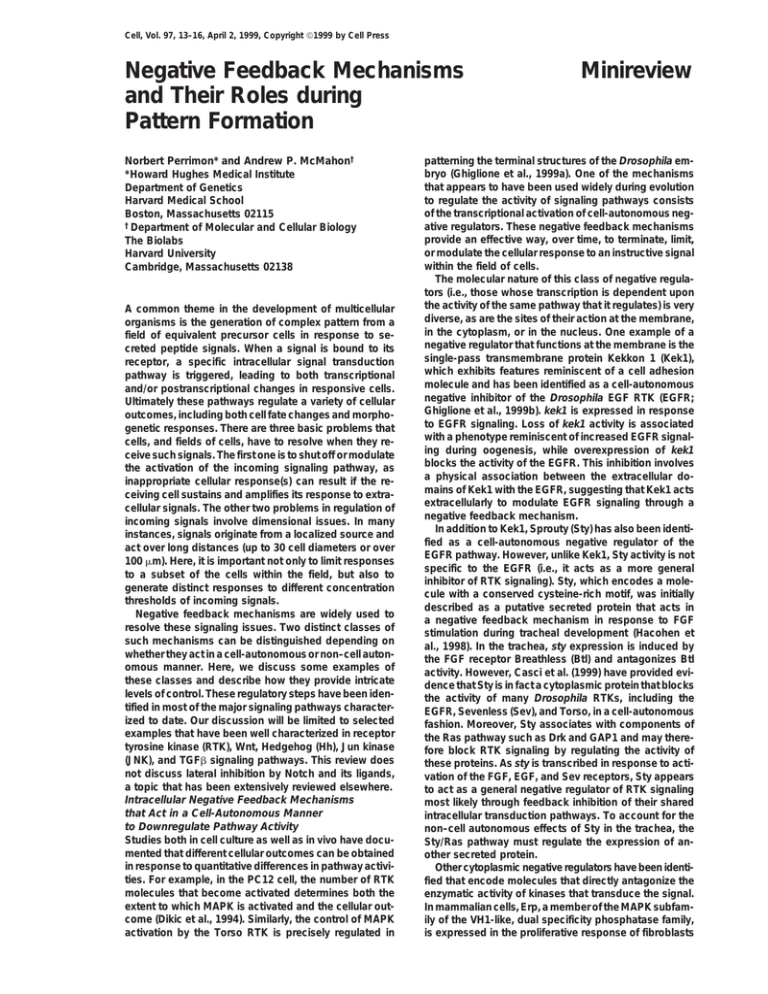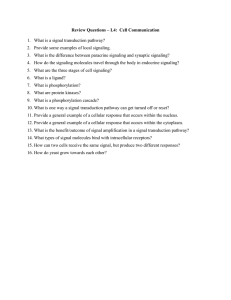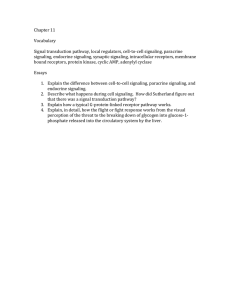Negative Feedback Mechanisms Minireview and Their Roles during
advertisement

Cell, Vol. 97, 13–16, April 2, 1999, Copyright 1999 by Cell Press Negative Feedback Mechanisms and Their Roles during Pattern Formation Norbert Perrimon* and Andrew P. McMahon† * Howard Hughes Medical Institute Department of Genetics Harvard Medical School Boston, Massachusetts 02115 † Department of Molecular and Cellular Biology The Biolabs Harvard University Cambridge, Massachusetts 02138 A common theme in the development of multicellular organisms is the generation of complex pattern from a field of equivalent precursor cells in response to secreted peptide signals. When a signal is bound to its receptor, a specific intracellular signal transduction pathway is triggered, leading to both transcriptional and/or postranscriptional changes in responsive cells. Ultimately these pathways regulate a variety of cellular outcomes, including both cell fate changes and morphogenetic responses. There are three basic problems that cells, and fields of cells, have to resolve when they receive such signals. The first one is to shut off or modulate the activation of the incoming signaling pathway, as inappropriate cellular response(s) can result if the receiving cell sustains and amplifies its response to extracellular signals. The other two problems in regulation of incoming signals involve dimensional issues. In many instances, signals originate from a localized source and act over long distances (up to 30 cell diameters or over 100 mm). Here, it is important not only to limit responses to a subset of the cells within the field, but also to generate distinct responses to different concentration thresholds of incoming signals. Negative feedback mechanisms are widely used to resolve these signaling issues. Two distinct classes of such mechanisms can be distinguished depending on whether they act in a cell-autonomous or non–cell autonomous manner. Here, we discuss some examples of these classes and describe how they provide intricate levels of control. These regulatory steps have been identified in most of the major signaling pathways characterized to date. Our discussion will be limited to selected examples that have been well characterized in receptor tyrosine kinase (RTK), Wnt, Hedgehog (Hh), Jun kinase (JNK), and TGFb signaling pathways. This review does not discuss lateral inhibition by Notch and its ligands, a topic that has been extensively reviewed elsewhere. Intracellular Negative Feedback Mechanisms that Act in a Cell-Autonomous Manner to Downregulate Pathway Activity Studies both in cell culture as well as in vivo have documented that different cellular outcomes can be obtained in response to quantitative differences in pathway activities. For example, in the PC12 cell, the number of RTK molecules that become activated determines both the extent to which MAPK is activated and the cellular outcome (Dikic et al., 1994). Similarly, the control of MAPK activation by the Torso RTK is precisely regulated in Minireview patterning the terminal structures of the Drosophila embryo (Ghiglione et al., 1999a). One of the mechanisms that appears to have been used widely during evolution to regulate the activity of signaling pathways consists of the transcriptional activation of cell-autonomous negative regulators. These negative feedback mechanisms provide an effective way, over time, to terminate, limit, or modulate the cellular response to an instructive signal within the field of cells. The molecular nature of this class of negative regulators (i.e., those whose transcription is dependent upon the activity of the same pathway that it regulates) is very diverse, as are the sites of their action at the membrane, in the cytoplasm, or in the nucleus. One example of a negative regulator that functions at the membrane is the single-pass transmembrane protein Kekkon 1 (Kek1), which exhibits features reminiscent of a cell adhesion molecule and has been identified as a cell-autonomous negative inhibitor of the Drosophila EGF RTK (EGFR; Ghiglione et al., 1999b). kek1 is expressed in response to EGFR signaling. Loss of kek1 activity is associated with a phenotype reminiscent of increased EGFR signaling during oogenesis, while overexpression of kek1 blocks the activity of the EGFR. This inhibition involves a physical association between the extracellular domains of Kek1 with the EGFR, suggesting that Kek1 acts extracellularly to modulate EGFR signaling through a negative feedback mechanism. In addition to Kek1, Sprouty (Sty) has also been identified as a cell-autonomous negative regulator of the EGFR pathway. However, unlike Kek1, Sty activity is not specific to the EGFR (i.e., it acts as a more general inhibitor of RTK signaling). Sty, which encodes a molecule with a conserved cysteine-rich motif, was initially described as a putative secreted protein that acts in a negative feedback mechanism in response to FGF stimulation during tracheal development (Hacohen et al., 1998). In the trachea, sty expression is induced by the FGF receptor Breathless (Btl) and antagonizes Btl activity. However, Casci et al. (1999) have provided evidence that Sty is in fact a cytoplasmic protein that blocks the activity of many Drosophila RTKs, including the EGFR, Sevenless (Sev), and Torso, in a cell-autonomous fashion. Moreover, Sty associates with components of the Ras pathway such as Drk and GAP1 and may therefore block RTK signaling by regulating the activity of these proteins. As sty is transcribed in response to activation of the FGF, EGF, and Sev receptors, Sty appears to act as a general negative regulator of RTK signaling most likely through feedback inhibition of their shared intracellular transduction pathways. To account for the non–cell autonomous effects of Sty in the trachea, the Sty/Ras pathway must regulate the expression of another secreted protein. Other cytoplasmic negative regulators have been identified that encode molecules that directly antagonize the enzymatic activity of kinases that transduce the signal. In mammalian cells, Erp, a member of the MAPK subfamily of the VH1-like, dual specificity phosphatase family, is expressed in the proliferative response of fibroblasts Cell 14 to serum. Constitutive expression of Erp in fibroblasts was found to suppress proliferation, suggesting that this phosphatase acts in a negative feedback mechanism (Nogushi et al., 1993). This model is supported by studies on the role of the JNK pathway in dorsal closure of the Drosophila embryo. During mid embryogenesis, the epidermis stretches dorsally and moves over the most dorsal cells of the amnioserosa. The current model is that a signal that originates from these most dorsal amnioserosa cells activates the JNK pathway in the leading edge of the epidermis. Among the downstream transcriptional targets of the JNK pathway is the puckered (puc) gene, which encodes a member of the VH1 phosphatases whose target is Drosophila JNK (MartinBlanco et al., 1998). In puc mutants, which fail to undergo the last step of dorsal closure, the levels of nonmuscle myosin and actin are reduced at the leading edge. As myosin has been proposed to participate in the control of cell shape changes at the leading edge and to control the movement of epidermal cells, this may explain the defect in closure. When puc is overexpressed, morphogenesis is perturbed as well and cells fail to undergo the appropriate cell shape changes essential for dorsal closure. Thus, Puc provides an example of how a cellautonomous negative regulator contributes to a specific morphogenetic event through a negative feedback mechanism. Some other negative regulators that act in feedback mechanisms encode dominant-negative forms of specific signal transducers. For example, SMAD7, which is expressed in response to TGFb signaling, binds to the TGFb receptor but does not become phosphorylated following TGFb stimulation. This association prevents the binding and phosphorylation of SMAD2 and SMAD3, an event that is required for transduction of the signal to the nucleus (Nakao et al., 1997). Further, Xenopus SMAD8 has been shown to be induced by BMP-4 and to antagonize BMP-4 activity during embryonic development (Nakayama et al., 1998). Similarly, in Drosophila a distantly related member of the SMAD family, Daughter Against Dpp (Dad), is transcriptionally regulated by the TGFb-related molecule Decapentaplegic (Dpp) and blocks Dpp signaling (Tsuneizumi et al., 1997). It has been suggested that the function of Drosophila Dad is to stabilize the gradient of positional information emanating from Dpp-expressing cells (Tsuneizumi et al., 1997). In addition to these cytoplasmic factors, a putative nuclear transcriptional repressor of Dpp, encoded by the gene brinker (brk), has recently been identified as a negative regulator of Dpp signaling (Campbell and Tomlinson, 1999; Jazwinska et al., 1999). Loss of brk in wing discs leads to cell-autonomous activation of downstream Dpp-target genes, an effect similar to those of an activated form of the type I Dpp receptor Thick Veins (Tkv). Consistent with Brk acting at the transcriptional level, Brk acts downstream of Mad. Mad is essential for all aspects of Dpp signaling and belongs to the family of receptor-regulated SMADs, which are transcriptional activators and are direct substrates of the activated type I receptor. However, unlike activated Tkv, which leads to effects that correspond to high levels of Dpp, loss of brk activity is associated with effects that correspond to low or intermediate levels of Dpp. Interestingly, brk expression in the imaginal discs is regulated by Dpp signaling. In the absence of Dpp signaling, brk is uniformly expressed in the wing pouch. However, in wild type, brk expression is complementary to regions of Dpp signaling, suggesting that Dpp emerging from the center of the wing pouch represses brk activity in order to allow the expression of downstream target genes. Thus, studies on brk have revealed a novel regulatory mechanism by which Dpp activates target genes that depend on low levels of signaling activity. Non–Cell Autonomous Negative Feedback Mechanisms In contrast to the cell-autonomous negative regulators described above, studies on the secreted Drosophila protein Argos (Aos) have provided a striking example of how a negative feedback mechanism can control the spatial activity of a specific signaling pathway. aos encodes a secreted inhibitor of the EGFR that is positively transcribed in response to EGFR activity. The protein contains a divergent EGF repeat, suggesting that Aos may directly interact with the extracellular domain of the EGFR (Freeman, 1996). Studies of Aos function in the embryo, eye, and follicle cells have illustrated how competition between Aos and the EGFR ligand Spitz (Spi), whose interaction with the EGFR it presumably antagonizes, results in the elaboration of complex patterns (Golembo et al., 1996; Wasserman and Freeman, 1998). For example, during oogenesis, activity of the EGFR in the follicle cell epithelial layer is initiated by Gurken/TGFa, a ligand that originates from the oocyte. Subsequently, activity of the EGFR is amplified in follicle cells through a Spi/EGFR pathway controlled by the multipass transmembrane protein Rhomboid (Rho). Rho, which is thought to play a role in the conversion of Spi from an inactive membrane-bound precursor to an active diffusible ligand, is transcriptionally regulated by EGFR signaling. The EGFR also stimulates the transcription of aos, which inhibits the EGFR in cells where it is most highly expressed. Because of the spatiotemporal aspect of this event, Aos alters the initial profile of EGFR activity, downregulating EFGR activity in the initial central domain of EGFR activity, leaving two lateral domains of signaling, which subsequently differentiate the two dorsal appendages of the egg (Wasserman and Freeman, 1998). Thus, the developmental logic of the aos negative feedback mechanism is to control the spatial regulation of the EGFR pathway and establish pattern. This same pathway also plays a central role in the progressive differentiation of photoreceptors and support cells in the Drosophila eye. Here, in their basic unit, the ommatidium, all cell fates ultimately depend on EGFR signaling. Differentiating cells produce Spi and Aos. As Aos appears to diffuse more readily, only cells in contact with those that produce Spi are induced to differentiate. More peripheral cells are inhibited by Aos. Hence, there is a progressive, radial recruitment of cells to the assembling ommatidial complex. In both examples, the negative feedback mechanisms allow the “self-assembly” of complex pattern by the inherent properties of the regulatory circuit. A variety of negative feedback mechanisms have also been demonstrated in the patterning of large fields of cells where instructive signals are commonly secreted Minireview 15 from a small domain or organizing center within the field. There is now compelling evidence that some secreted ligands act as morphogens, forming long-range gradients that trigger differential responses within a field of equivalent cells. Here, the modulation of receptor distribution plays a critical role in regulating the cellular response within a field of equivalent cells. For example, in the case of Hh signaling, Chen and Struhl (1996) showed that the receptor can act as a sink for the ligand. Hh activates its signal transduction pathway following binding to its receptor, the multipass membrane protein Patched (Ptc). This response is limited to cells close to the source of Hh. However, in clones of ptc mutant cells that do not express Ptc protein, Hh travels through the mutant clone and triggers a response in distal cells. Thus, the presence of Ptc limits the range of Hh action. Interestingly, studies in both Drosophila and vertebrates have documented that one of the first responses to Hh signaling is the upregulation of ptc itself. Thus, the levels of ptc expression correlate with the strength of Hh signaling. As Ptc is a negative regulator of Hh signaling, this negative feedback mechanism may not only limit the range of Hh action, but also sharpen the response of cells to a small difference in the Hh gradient. In addition to Ptc, a novel membrane-bound protein, Hedgehog-interacting protein (Hip), has recently been identified in vertebrates (Chuang and McMahon, 1999). Like Ptc, it binds all vertebrate Hh proteins; it is a transcriptional target and negatively regulates Hh signaling. The current absence of a Hip counterpart in Drosophila raises the intriguing possibility that additional negative feedback mechanisms may have evolved to regulate Hh action during vertebrate morphogenesis. Modulation of receptor levels by incoming signals has now been observed in the case of two other Drosophila signals, Dpp and Wingless (Wg, a member of the Wnt family). However, here both receptors are negatively regulated by their respective signaling pathways. Longrange signaling is directly mediated by Dpp, in part through binding to the Tkv receptor. The ability of Dpp to diffuse over long distances appears to involve precise regulation of expression of the tkv receptor (Lecuit and Cohen, 1998). tkv is expressed at low levels in the center of the disc and at higher levels toward the edges. Dpp reduces expression of tkv, and a high level of receptors decreases the effective range of the Dpp gradient, as visualized by expression of downstream target genes. Thus, like Hh and Ptc, elevated levels of receptors apparently limit the effective range of Dpp diffusion, possibly by sequestering it. Further, the level of expression of the Tkv receptor was also found to influence the sensitivity of cells to Dpp. The control of receptor levels by ligands appears to be an effective mechanism to modulate the shape of the ligand gradient as well as its response. Wg also regulates the expression of its own receptor to modulate the shape of both the activity gradient and the ligand gradient (Cadigan et al., 1998). In the wing imaginal disc, wg is expressed at the dorsoventral boundary where it acts over a distance of around 25 cell diameters to pattern the wing blade. Where Wg concentration is highest in the center of the disc, its receptor Dfz2, which encodes a multipass transmembrane protein, is downregulated. Dfz2 is expressed at Figure 1. Multiple Levels of Control of a Signaling Pathway by Negative Feedback Mechanisms Molecules that act in a negative feedback mechanism are indicated. 1, 2, and n refer to the various molecules that transduce the signal from the membrane to the nucleus. the highest levels in cells distant from the source of Wg. Interestingly, high levels of Dfz2 were found to stabilize low levels of Wg, but surprisingly Wg was still able to move between cells. Thus, the Wg receptor broadens the range of Wg action by protecting Wg from degradation. Consequently, as a result of downregulation of Dfz2 by high levels of Wg signaling centrally, and stabilization of Wg by high levels of Dfz2 peripherally, a biphasic gradient of signaling activity, steeply declining then plateauing, is generated across the wing disc. Finally, a similar downregulation of receptor levels by pathway activity has been suggested for the EGFR. Sturtevant et al. (1994) reported that levels of EGFR mRNAs are strongly downregulated in cells that have recently undergone high levels of EGFR signaling. However, the developmental function of this regulation is unclear. Perspectives Throughout the examples described above, it is apparent that negative feedback mechanisms provide intricate levels of control and are commonly used to orchestrate various patterning events. Remarkably, as is the case of the EGFR, multiple negative feedback mechanisms that include proteins that act in a cell-autonomous (Sty and Kek1) or non–cell autonomous (Aos) manner have been identified for a single signaling pathway (Figure 1). Similarly, in the case of Dpp/TGFb signaling, multiple negative feedback mechanisms have been identified (Brk, SMADs, and Dad). As other pathways are explored in more depth, it is likely that negative feedback mechanisms operating at multiple levels within a signal transduction pathway will become a recurring theme. Cell 16 Importantly, little or no information is available on the transcriptional regulation of a number of negative regulators (i.e., Axins for Wnt signaling, some of the SMADs, and SOCS/JABS/CIS and PIAS for JAK/STAT pathways). Thus, careful examination of the transcriptional regulation of these negative regulators may reveal that some of them are indeed regulated by the activity of the signaling pathway they inhibit. Finally, several secreted negative regulators of specific signaling pathways have been described that are not thought to work in feedback mechanisms (i.e., Chordin/SOG for Dpp/BMPs and sFRPs for Wnts). It will be of interest to determine whether this is true in all aspects of their embyronic and/or adult roles. Understanding how they are regulated may well provide insight into the cross-talk between different signaling pathways. In summary, we can expect that studies of negative feedback mechanisms will reveal a great number of new insights into pattern formation. Clearly, a critical issue in understanding the biological functions of negative feedback mechanisms will be to characterize their thresholds for inhibitor induction, diffusion ranges, and cellular autonomy. Understanding these parameters will be particularly important in understanding how graded signaling through a field of cells is established. For example, inhibitors that have low thresholds for induction (i.e., Kek1 or Dad) uniformally reduce signaling, thus maintaining the graded signaling pattern. On the other hand, diffusible inhibitors that have a high threshold for induction generate local elaborations of the pattern if their diffusion is limited compared to that of the activating ligands (i.e., Aos in dorsal appendage formation). However, if such inhibitors are made in the same cells that produce the secreted ligand but can diffuse more efficiently, they essentially fulfill the same role as cell-autonomous inhibitors. Selected Reading Cadigan, K.M., Fish, M.P., Rulifson, E.J., and Nusse, R. (1998). Cell 93, 767–777. Campbell, G., and Tomlinson, A. (1999). Cell 96, 553–562. Casci, T., Vinos, J., and Freeman, M. (1999). Cell 96, 655–665. Chen, Y., and Struhl, G. (1996). Cell 87, 553–563. Chuang, P., and McMahon, A.P. (1999). Nature 397, 617–621. Dikic, I., Schlessinger, J., and Lax, I. (1994). Curr. Biol. 4, 702–708. Freeman, M. (1996). Cell 87, 651–660. Ghiglione, C., Perrimon, N., and Perkins, L. (1999a). Dev. Biol. 205, 181–193. Ghiglione, C., Carraway, K.L., Amundadottir, L.T., Boswell, R.E., Perrimon, N., and Duffy, J.B. (1999b). Cell 96, 847–856. Golembo, M., Schweitzer, R., Freeman, M., and Shilo, B.Z. (1996). Development 122, 223–230. Hacohen, N., Kramer, S., Sutherland, D., Hiromoi, Y., and Krasnow, M.A. (1998). Cell 92, 253–263. Jazwinska, A., Kirov, N., Wieschaus, E., Roth, S., and Rushlow, C. (1999). Cell 96, 563–573. Lecuit, T., and Cohen, S. (1998). Development 125, 4901–4907. Martin-Blanco, E., Gampel, A., Ring, J., Virdee, K., Kirov, N., Tolkovsky, A.M., and Martinez-Arias, A. (1998). Genes Dev. 12, 557–570. Nakao, A., Afrakhte, M., Moren, A., Nakayama, T., Christian, J.L., Heuchel, R., Itoh, S., Kawabata, M., Heldin, N.E., Heldin, C.H., and ten Dijke, P. (1997). Nature 389, 631–635. Nakayama, T., Snyder, M.A., Grewald, S.S., Tsuneizumi, K., Tabata, T., and Christian, J.L. (1998). Development 125, 857–867. Nogushi, T., Metz, R., Chen, L., Mattei, M.G., and Bravo, R. (1993). Mol. Cell. Biol. 13, 5195–5205. Sturtevant, M.A., O’Neill, J.W., and Bier, E. (1994). Development 120, 2593–2600. Tsuneizumi, K., Nakayama, T., Kamoshida, Y., Kornberg, T.B., Christian, J.L., and Tabata, T. (1997). Nature 389, 627–631. Wasserman, J.D., and Freeman, M. (1998). Cell 95, 355–364.





